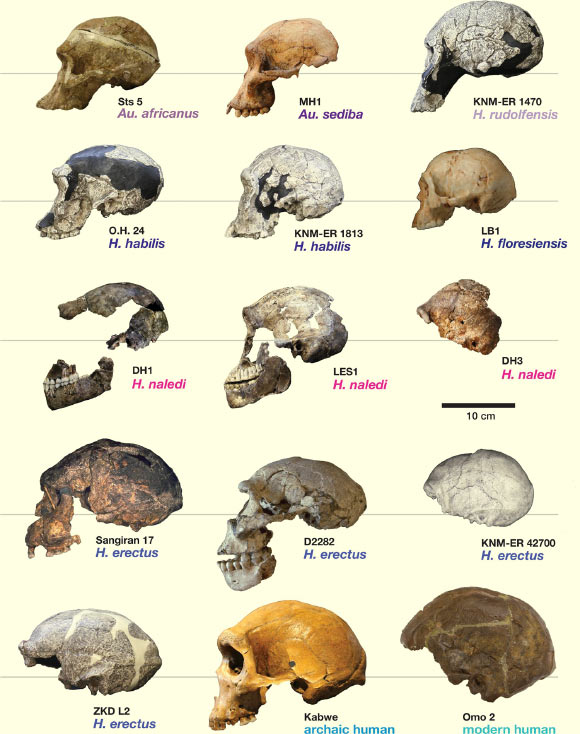A species of extinct hominin called Homo naledi was discovered in 2013 in a remote cave chamber of the Rising Star cave system in South Africa. This species survived until 335,000-226,000 years ago, placing it in continental Africa at the same time as the early ancestors of anatomically modern humans were arising. According to new research, despite its small brain size, Homo naledi shared several aspects of structure in common with other species of the genus Homo (H. habilis, H. rudolfensis, H. floresiensis, and H. erectus), not found in other hominins or great apes, suggesting that innovations in brain structure were ancestral within our genus.

A reconstruction of Homo naledi’s head by paleoartist John Gurche. Image credit: John Gurche / Mark Thiessen / National Geographic.
An international team of paleoanthropologists from the University of Witwatersrand, Columbia University, and Indiana University pieced together traces of Homo naledi’s brain shape from an extraordinary collection of skull fragments and partial crania, from at least five adult individuals.
One of these bore a very clear imprint of the convolutions on the surface of the brain’s left frontal lobe.
“The anatomy of Homo naledi’s frontal lobe was similar to humans, and very different from great apes,” the scientists said.
“Other members of our genus, from Homo erectus to Homo habilis and the small-brained Homo floresiensis, also share features of the frontal lobe with living humans.”
But earlier human relatives, like Australopithecus africanus, had a much more apelike shape in this part of the brain, suggesting that functional changes in this brain region emerged within the genus Homo.
“It’s too soon to speculate about language or communication in Homo naledi, but today human language relies upon this brain region,” said co-author Dr. Shawn Hurst, a researcher in the Department of Anthropology at Indiana University.
“The back of the brain also showed humanlike changes in Homo naledi compared to more primitive hominins like Australopithecus.”
Human brains are usually asymmetrical, with the left brain displaced forward relative to the right.
The researchers found signs of this asymmetry in one of the most complete Homo naledi skull fragments.
They also found hints that the visual area of the brain, in the back of the cortex, was relatively smaller in Homo naledi than in chimpanzees — another humanlike trait.

Comparison of Homo naledi skulls to skulls of other hominin species. Image credit: Hawks et al, doi: 10.7554/eLife.24232.
The small brains of Homo naledi raise new questions about the evolution of human brain size.
Big brains were costly to human ancestors, and some species may have paid the costs with richer diets, hunting and gathering, and longer childhoods. But that scenario doesn’t seem to work well for Homo naledi, which had hands well-suited for tool-making, long legs, humanlike feet, and teeth suggesting a high-quality diet.
“Homo naledi’s brain seems like one you might predict for Homo habilis, 2 million years ago. But Homo habilis didn’t have such a tiny brain — Homo naledi did,” said co-author Dr. John Hawks, from the Evolutionary Studies Institute at the University of Witwatersrand.
A humanlike brain organization might mean that Homo naledi shared some behaviors with humans despite having a much smaller brain size.
“The recognition of Homo naledi’s small but complex brain will also have a significant impact on the study of African archaeology,” said co-author Professor Lee Berger, also from the Evolutionary Studies Institute at the University of Witwatersrand.
“Archaeologists have been too quick to assume that complex stone tool industries were made by modern humans. With Homo naledi being found in southern Africa, at the same time and place that the Middle Stone Age industry emerged, maybe we’ve had the story wrong the whole time.”
The research was published online this week in the Proceedings of the National Academy of Sciences.
_____
Ralph L. Holloway et al. Endocast morphology of Homo naledi from the Dinaledi Chamber, South Africa. PNAS, publihsed online May 14, 2018; doi: 10.1073/pnas.1720842115







